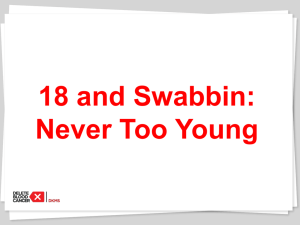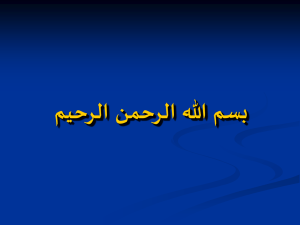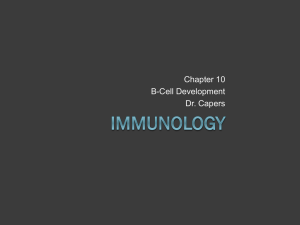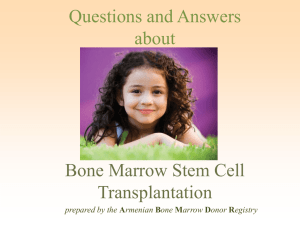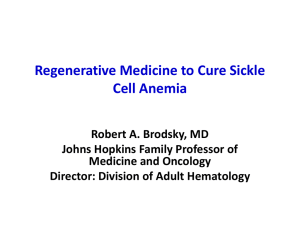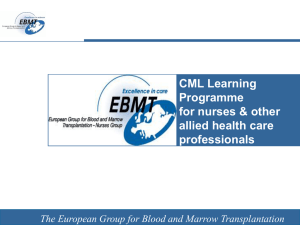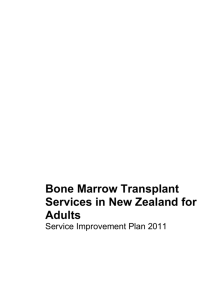Bone marrow and stem cell transplantation A global perspective
advertisement
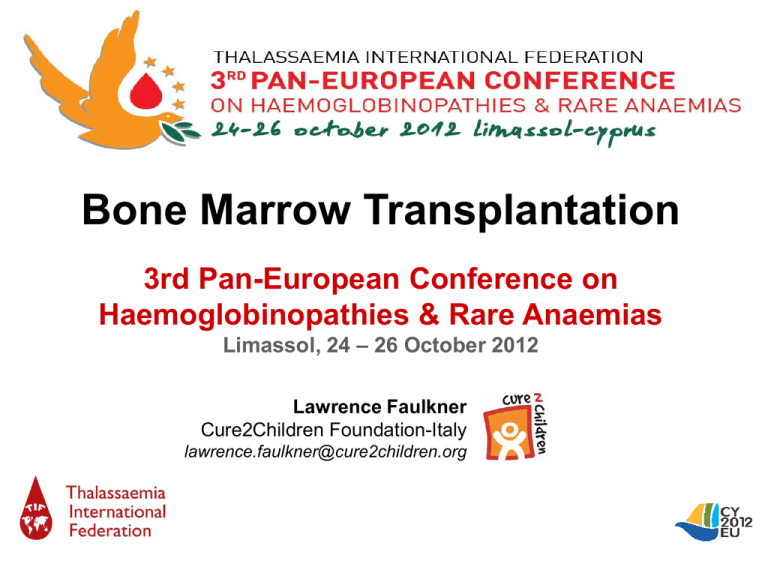
Bone Marrow Transplantation 3rd Pan-European Conference on Haemoglobinopathies & Rare Anaemias Limassol, 24 – 26 October 2012 Lawrence Faulkner Cure2Children Foundation-Italy lawrence.faulkner@cure2children.org Bone marrow and stem cell transplantation BMT in the “new thalassemic” era Mortality and morbidity Quality of life Cost-effectiveness Global perspective Risk Classes for BMT in Thalassemia Standard preparation with Busulfan-Cyclophosphamide (BuCy) Chelation Hepatomegaly Fibrosis Class 1 Regular No No Class 2 Reg/Irreg No/yes No/Yes Class 3 Irregular Yes yes Patients < 17 year OS TFS Class 1 94% 87% Class 2 84% 81% Class 3 70% 58% Adults OS TFS 67% 63% Emanuele Angelucci: Hematopoietic stem cell transplantation for Thalassemia. ASH Educational Book 2010 Bone marrow and stem cell transplantation Late effects Infertility Delayed puberty (females) • Impaired growth and development (TBI) • Second malignancies (TBI) • Intellectual impairment (CNS-directed therapy) Quality of life post-BMT Caocci G, et al. EBMT 2012: P1034 54 patients (26 females and 28 males) after a mean of 20 years from sibling donor BMT compared to 41 sibling donors. Mean age at BMT 14 yrs (currently 38 yrs) and 18 (currently 41 yrs) for patients and donors, respectively. Chronic graft versus host disease reported in 18.5%. Patients had lower QoL scores for vitality, physical & social functioning Patient Donor sibling Working 67% 80% Living with spouse/partner 40% 61% Had babies 15% 31% Bone marrow and stem cell transplantation Splenectomy and BMT Enlarged spleen per se is not associated with higher rejection rates May increase transfusion requirements and delay engraftment Splenectomy may be associated with increased transplantrelated mortality. Mathews et al. Pediatr Transplant. 2009;13(2):171–176 Bone marrow and stem cell transplantation Hepatitis C and BMT No evidence that BMT has any influence on the course of HCV infection or vice versa. Hepatitis C and iron overload may accelerate progression of liver fibrosis Erer et al. Bone Marrow Transplant.,1994;14(3):369–372 Angelucci et al. Blood, 2002;100(1):17–21 HCV positivity may thus actually strengthen the indication for BMT if proper supportive care is not available Bone marrow and stem cell transplantation Cost-effectiveness A cost-utility and budget impact analysis of allogeneic hematopoietic stem cell transplantation for severe thalassemic patients in Thailand Leelahavarong et al. BMC Health Services Research 2010, 10:209 (http://www.biomedcentral.com/1472-6963/10/209 Bone marrow and stem cell transplantation A global perspective Thalassemia in Pakistan • Thalassemia carriers 5% population • Total Carriers 8 million • Thalassaemia births/year 5,000 – 6,000 • Thalassaemia Major prevalence ~ 60,000 • ~ 4% national health budget goes to thalassemia care (for appropriate management it would have to increase to 40%). • Thalassemia is the main donated blood consumer Thalassemia Pakistan vs. UK Prevalence New cases/year UK 700 30 Pakistan 60.000 5.000 Thalassaemia statistics in Pakistan Age Groups 0-10 years : 75.6% 11-20 years: 24.1% 21-40 years: 0.3% Thalassemia survival in Pakistan 120 100 80 1996 2006 60 40 20 0 2 4 6 8 10 12 14 16 18 20 22 24 25 1996: data from HBB Karachi, 2006: data from BTIHS, Karachi Mission Cure2Children (C2C) is a non-profit, apolitical, and secular organization providing support for the care of children with cancer and severe blood disorder in developing countries. Pakistan Ayesha 8 y/o with thalassemia transplanted in Italy BMT for thalassemia Lucarelli G at al., 500 class 1-2 pts 85% Irfan M et al., JPMA 2008 60% Infections? Skills? Patient selection? Family support? Objectives of the Pakistan project 1. > 80% cure il low-risk patients with a matched sibling 2. Increase awareness and access to cure, screening and prevention Prospective (clinical management-oriented) database Computerized treatment plans (Excel format) Local personnel Jaipur Rajhastan-India Bone marrow and stem cell transplantation A global perspective Outcome of the first 12 low risk patients age <6 y, liver <2cm, matched sibling donor: 6 at PIMS-Pakistan 6 at SEAIT-Jaipur 92% cure Bone marrow and stem cell transplantation A global perspective PIMS Pakistan SEAIT India Construction & Renovation Furniture & Equipments Total 11,000$ 24,000$ 35,000$ 135,000$ 29,000$ 164,000$ Bone marrow and stem cell transplantation Costs (low-risk, compatible sibling) Blood products Hospital charges Surgical Pharmacy Professionals $1,700 $200 $600 $300 $2,100 $4,600 $900 $10,700 India (SEAIT) $500 $2,500 $200 $3,100 $1,800 $4,600 $1,200 $900 $15,000 Total Diagnostics $400 Follow up Pre-BMTevaluation Pakistan (PIMS) Indirect positive effects of BMT Increases awareness about thalassemia Attracts families for screening Generates prevention resources for supportive care and Increase compliance with chelation and use of safe blood Attracts and motivate professionals Empowers medical centers and paves the way for the cure of related disorders Accessible HLA screening Poster session, El Missiry et al.: HLA-typing by buccal swab to facilitate acees to bone marrow transplantation globally. Abstract book page 104 Bone marrow and stem cell transplantation Thalassemia vs. Sickle cell disease Thalassemia Sickle cell disease New cases/year > 80,000 > 250,000 Total BMTs done ~ 3,000 ~ 300 Risk group identification Good Poor Transplant related mortality 5-40% 5-10% Chelation effective but expensive Hydroxyurea inexpensive but partially effective Potentially good Variable Highly dependent on medical care Potentially good with modest care Medical therapy Quality of life Life expectancy Prospects Partially matched related (haploidentical) BMT for sickle cell disease Haplo BMT (14 pts: 15-42 yrs) Mortality III-IV GVHD Graft failure 0% 0% 43% Bolanos-Meade et al. Blood 2012;118:282 Prospects Double unrelated cord blood vs. Haploidentical marrow Results of 2 parallel phase 2 trials (adult leukemia/lymphoma pts ) 1-yr nonrelapse mortality d100 II-IV GVHD Median ANC recovery (>500) Median plt recovery (>20K) Graft failure Stem cell source cost dUCB (50 pts) 24% 40% d15 d30 12% >60.000$ Haplo BMT (50 pts) 7% 32% d16 d24 2% 0 Brunstein et al. Blood 2011;118:282 The role of third-party international professional organizations Foster the use of common protocols and procedures Reassure patients and professionals in the early phase Decrease unnecessary expenses Increased scientific visibility Support fund-development Provide network referrals Promote screening and prevention Bone marrow and stem cell transplantation Conclusions BMT outcomes are improving in parallel with supportive and thus indications in severe thalassemia are still controversial, at least in affluent countries In thalassemia-prone regions where appropriate long-term supportive care might not be readily accessible and resources limited, BMT is feasible, cost-effective and can save lives. Thalassemia associations, NGOs and professional networks may play an important role to promote non-profit and ethical BMT programs In emerging countries better access to BMT may increases hope and thus improve compliance with supportive care BMT programs may increase awareness, attract professionals and promote prevention Thank you lawrence.faulkner@cure2children.org

